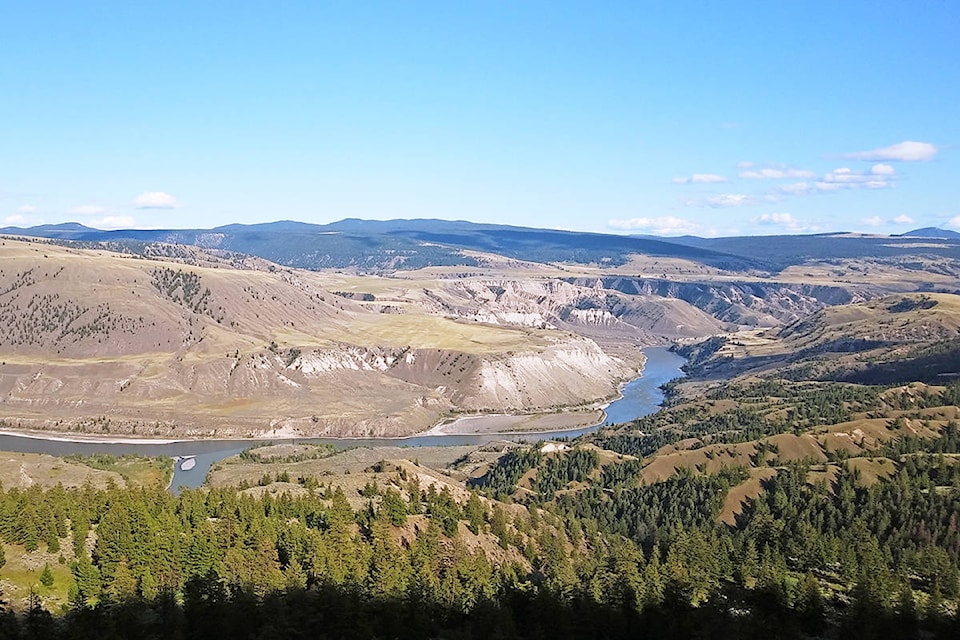Creek fishing near Indian Reserve 12 remains a distant memory for ?Esdilagh First Nation members, who said they have largely abandoned their lands south of Quesnel due to nearby mining.
“People are afraid to use the water in the area,” said ?Esdilagh First Nation Coun. Howard Johnny of IR #12, pointing to the community’s concerns about the potential impacts from the adjacent Gibraltar mine on water quality in the area.
Johnny was one of several guest speakers participating in an online webinar held Wednesday, May 12, to discuss mining pollution and the recognition of Indigenous laws to protect watersheds.
The Indigenous community located on both sides of the Fraser River between Quesnel and Williams Lake remains determined to protect the river’s water quality for future generations, considering the Fraser River to be a critical provider of traditional food sources, sacred ceremonies and cultural practices.
Joining the Tsilhqot’in Nation was Nadleh Whut’en First Nation near Fort Fraser in north-central B.C., who have forbid any future development in their territories without their consent.
Read More: Alaska demands action on B.C.’s ‘lax’ mining oversight
“Our relationship to water and natural resources is different from those of most non-Indigenous Canadians,” said Nadleh Whut’en Chief Larry Nooski.
“When it comes to mining in our territory, dilution is not the solution.”
In 2016 Nadleh Whut’en and Stellat’en enacted a water management regime — Yinka Dene ‘Uza’hné — to regulate the surface waters throughout their territories.
Environmental engineer Dr. Rina Freed used the molybdenum Endako mine as an example of some success.
There are several discharges from the Endako mine that flow into streams as well as the Endako River and Francois Lake eventually entering the Fraser River.
Freed said in 2015, the B.C. Ministry of Environment acknowledged Nadleh Whut’en’s concerns of potential impacts from concentrations of metals and minerals in the discharged effluent, and a working water quality group was established.
“As the relationship with the Ministry of Environment stabilized and improved, communications opened up between all the parties,” Freed said.
Although the provincial or federal governments have not officially recognized their surface water policy, regulatory instruments have provided formal recognition of it for the Endako mine and proposed Blackwater mine.
Read More: Northern B.C. First Nations wrap up testimony against Rio Tinto (Alcan), B.C. and Canada
When the Endako mine opened in 1964 Nooski said there was a lot of resistance for any involvement of local First Nations, adding the provincial political landscape changed when the B.C. Government sought to get liquefied natural gas (LNG) off the ground.
“Government to government management was one of the requirements that we had in terms of turning around the provincial laws,” he said.
“There were a few upper hands that provided us the ability to move forward with our water law.”
A proposal to combine all discharges that would bypass tributaries directly into Francois Lake via an existing channel or pipeline was revised by Endako mine after the water quality group recommended sending discharges north of the Endako River.
Freed said this would minimize the impacts to waters of the highest level of protection and also consolidate effluent towards a central collection point for future water treatment.
“Continuous improvement is realized by setting firm deadlines to more stringent targets as we progress through a process that spans over 15 years,” she said.
?Esdilagh First Nation Chief and Council adopted its written ?Elhdaqox Dechen Ts’edilhtan (?Esdilagh Sturgeon River Law) last May to exercise their right to govern the use and management of waters in their territory to ensure it is safe and clean for future and current generations.
Read More: B.C. First Nation adopts historic law to protect Fraser River
The Environmental Appeal Board has scheduled two days of electronic closing hearings on Thursday, May 20 and Friday, May 21 for an appeal launched by the Tsilhqot’in National Government challenging a permit authorizing Gibraltar mine a 50 per cent increase in effluent discharge from its tailings pond directly into the Fraser River four kilometers downstream from ?Esdilagh and upstream from the Tsilhqot’in community of Tl’esqox.
Taseko Mines has stated discharged water meets water quality standards except for sulphate and nitrate.
“This is the crux of the issue,” said Tsilhqot’in National Government water, lands and resources senior adviser, J.P. Laplante.
“That the Fraser River is being effectively used as a sewer.”
Violations of Indigenous laws protecting water and the Tsilhqot’in Nation’s right to use, manage and benefit from their lands and waters, according to Laplante, have led to mismanagement resulting in the Tsilhqot’in no longer managing for abundance but scarcity.
The Tsilhqot’in have observed declines in sturgeon, salmon and other four-legged species such as moose across their territory.
Read More: Tsilhqot’in National Government appeals Gibraltar Mines’ permit to discharge into Fraser River
Do you have a comment about this story? email:
rebecca.dyok@wltribune.com
Like us on Facebook and follow us on Twitter.
